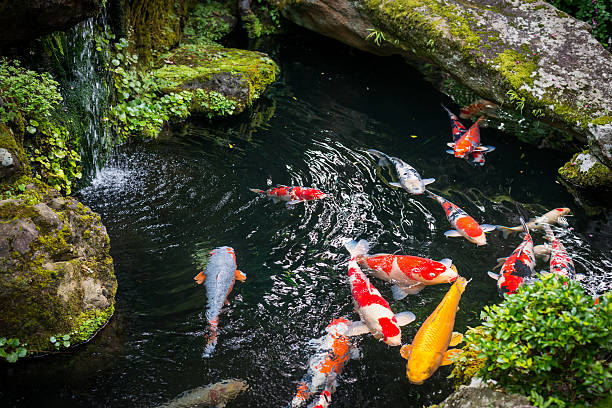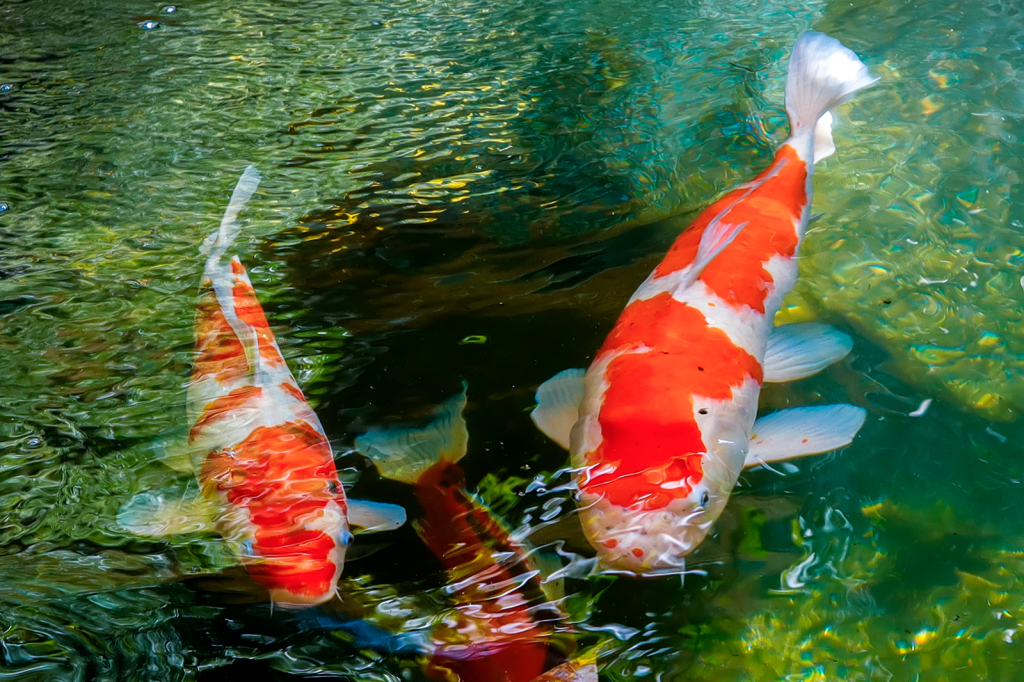
In spite of their hardiness and attractiveness, Koi is one of the most popular ornamental pond fish around, encompassing over 100 different varieties. In general, they require water at least a meter deep, 1,000 gallons, and a pH of 7.5 to 8, as well as a temperature between 55 and 79 degrees Fahrenheit. In contrast, if you plan to populate your pond with plants that are ideal for Koi, you might have to do some extra work in the process of doing so.
Regardless of other inhabitants of a pond – plants serve a variety of essential functions and are a good addition to any pond regardless of the other inhabitants. As a matter of fact, some species of aquatic plants are excellent oxygenators of water, and most provide shelter as well as food for all sorts of creatures found in ponds, whether they be fish, frogs, birds, or snails. These can all contribute to your pond’s biodiversity, health, and charm. Then there are still others that help absorb excess nutrients, such as fertilizers, and harmful nitrates, in order to prevent algae from overgrowing. Aside from providing shade, plants help regulate the temperature of your pond naturally, as well as provide a secure surface for female Koi to lay their eggs. The innumerable benefits these plants provide to your Koi pond make it worth planting in but which ones should you plant? Let’s learn more about what are the different types of plants you can grow in your koi pond and their benefits.
Buying plants for your koi pond is fairly straightforward, but figuring out which ones are best for your pond fish will take more time. For koi ponds, we recommend the following pond plant species:
Water Lotus
There is no need for maintenance for lotuses, but they do require certain conditions to flourish such as a minimum of 5 hours of sunlight per day and a temperature of approximately 75 to 87°F the best conditions for them. They also need water that is at least 18 inches deep and has a low humidity level. These exotic-looking plants will also need lots of space as they can form up to 2 ft., so they are best suited to larger koi ponds. Lotus varieties are available in dwarf varieties for smaller ponds. In addition to providing ample shade in the summer months while supporting local pollinators, lotuses are not particularly palatable to Koi.
Water Lettuce
In addition to providing shelter from the sun and shade, this floating plant also provides food for your Koi. Moreover, algae are naturally removed by these water plants through their extensive root systems, which filter excess nutrients and compete with the sun for the light that algae require to grow. Water lettuce is very low maintenance, it prefers a temperature range of 66 to 80°F and can be grown in shallow water as a few inches deep and as deep as 30 feet deep. Water lettuce only needs a few inches of shallow water to survive and takes little effort to establish and maintain. As a single plant can cover an area of up to three feet in diameter as well as cover a large number of plants, a few of these guys go a long way. It is considered one of the best-adapted species in the world, and it can be found on every continent except Antarctica.
Water Hyacinth
The water hyacinth is a free-floating, surface water plant that is found in shallow waters as well as deep waters that are several meters deep. These floating plants don’t need much care and are capable of growing in temperate regions close to the equator, as well as the northernmost reaches of the U.S. Furthermore, the plants produce purple and blue flowers, and this, in turn, will attract pollinating species like hummingbirds and bees, which are crucial to the health of our ecosystem. Although water hyacinths do appear to be attractive to Koi, you may want to deter them from nibbling on them since the floating plant can reproduce and spread readily. Plants will be crowded out if they are not prevented from growing by predation or manual removal. To prevent clogging from leftovers, you will have to regularly clean your filter since Koi like to eat them.
Water Lily
A very popular water plant for either koi pond or garden pond, lilies are similar to lotuses but smaller and tolerant of cooler temperatures. In addition to floating pond plants, they have striking and fragrant flowers and can grow in as little as six inches of water or several feet of water. The Koi will feed on the leaves and roots of lily pads as well as hide under their pads to lay eggs.
Eelgrass
A submerged oxygenating plant known as eelgrass is considered to be among the top of the list. Koi and other large pond fish rarely rip them up or browse them since they are so resilient. Their wavy, grass-like leaves provide plenty of habitat and shade for your Koi in deeper ponds, however, where they can grow to several feet tall.
Scouring Rush
Scouring rushes are hardy, prehistoric plants that grow along the edges of water bodies or in water that is only a few inches deep. They have been around for hundreds of millions of years and are the only ones left of their kind. Similar to the horsetail, which belongs to the Equisetum genus, the horsetail has a very similar function. Their tall segments hold water and can be removed without harming the plants, and their ability to filter water is excellent. They are not generally aggressive or out-compete other pond plants, and if they become too numerous, they can be removed reasonably easily. To prevent them from returning, you’ll have to carefully pull up the rhizomes because they have a deep root system. It is not uncommon for Koi to use horsetails as a shelter, but they do not often eat them.

Conclusion
The presence of pond plants can be a wonderful addition to your pond, as they provide a great aesthetic effect as well as make your pond oxygenate and filter naturally. However, they should only be regarded as enhancements and not as a substitute for proper water maintenance and pond filtration. It’s important to ensure that both your pond fish and plants (submerged plants or floating plants) flourish in your pond by using mechanical pond filters, aerators, and a regular maintenance routine.
It may be hard to choose the best plants that will fit your own unique pond but the process of choosing is rewarding and exciting in its own way.
FAQs
Will my Koi eat the plants?
Your Koi will probably sample your pond plants, so yes, they will do this. The palatable nature of some is different from that of others for the Koi. Among the plants, they enjoy eating are water hyacinths, water lilies, and water lettuce roots. As a result, you will have to feed less supplemental food, and the plant population will naturally decline–saving you time in trying to maintain your plants.


